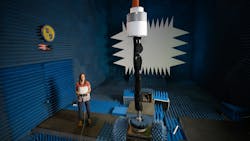Navy researchers use 3D printing to speed production and shrink size and weight of new radar antennas
WASHINGTON – Scientists at the U.S. Naval Research Laboratory (NRL) in Washington have produced miniaturized radar antennas from computer-aided-design (CAD) models and 3D printing techniques as a faster alternative to designing and developing radar antennas. Jack Browne at Microwaves & RF reports. Continue reading original article
The Military & Aerospace Electronics take:
16 April 2021 -- The antennas and arrays also are a fraction of the weight of existing components, offering naval system designers opportunities to employ the antennas in a wide variety of applications.
NRL electrical engineer Anna Stumme explains that the miniaturization and light weight result as a departure from the machining of solid metals during traditional antenna production processes and using composite materials in the 3D additive manufacturing methods.
“3D printing is a way to produce rapid prototypes and get through multiple design iterations very quickly, with minimal cost," Stumme says. "The light weight of the printed parts also allows us to take technology to new applications, where the heavy weight of solid metal parts used to restrict us.”
Related: The dawn of military 3D printing
Related: The electronics design challenges of hypersonic flight
John Keller, chief editor
Military & Aerospace Electronics

